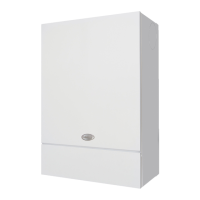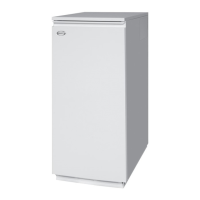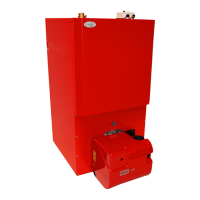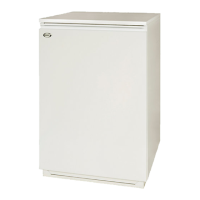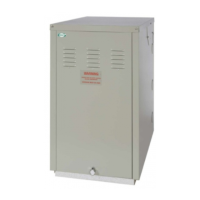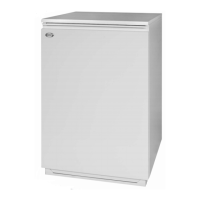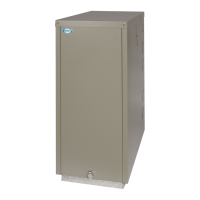6.5 CONDENSATE SOAKAWAY
To keep external pipework to a minimum, locate the soakaway
as close as possible to the boiler but ensure it is at least 500 mm
from building foundations and away from other services, e.g. gas,
electricity, etc.
The condensate pipe may be run above or below ground level
and can enter either the top or side of the soakaway tube. Refer
to Figure 6-1.
Ensure that the drainage holes in the soakaway tube face away
from the building.
Backll both the soakaway tube, and the hole around it, with 10
mm limestone chippings.
Only use a soakaway where the soil is porous and drains easily.
Do not use in clay soils or where the soil is poorly drained.
! CAUTION !
Any damage due to condensate backing up into the boiler
due to a high water table, in the case of a soakaway, or
ooded drains when the condensate disposal is via a
gulley or soil stack, is not covered by the Grant product
guarantee.
6.6 CONDENSATE TRAP
Grant Vortex boilers are supplied with a condensate trap to
provide the required 75 mm water seal in the condensate
discharge pipe from the boiler.
The condensate trap is factory tted inside the boiler casing -
mounted on the inside of the left hand side panel at the rear of the
boiler - in an accessible position to allow for routine maintenance,
see Figure 6-2.
This trap incorporates a oat (which will create a seal when the
trap is empty) and an overow warning outlet (tted with a plastic
sealing cap), see Figure 6-3.
! NOTE !
Access must be available to allow for routine maintenance.
A exible hose connects the outlet of the condensing heat
exchanger to the trap inlet. Ensure the elbow connector on the
hose is fully pushed onto the ‘top hat’ inlet connector of the trap.
With the trap tted inside the boiler casing, the sealing cap must
be tted. If the trap is re-located outside the boiler, then the
following applies:
• If connecting the condensate discharge - either internally or
externally - into a waste system or soil stack - the sealing cap
must be tted in the trap outlet.
• On external discharge systems to a hopper, gully or
soakaway, the sealing cap should be removed from the trap
outlet.
• If there is any discharge of condensate from the overow
outlet, this could indicate a blockage (possibly due to
freezing). Turn o the boiler and investigate the cause. If
necessary contact your service engineer for assistance.
! WARNING !
Care should be taken when siting the trap such that the
overow outlet is readily visible and that any condensate
overowing from the outlet cannot cause either a hazard to
persons or damage to surrounding property or equipment.
Section 6: Condensate DisposalPage 18
Condensate
trap
Condensate
outlet to drain
Flexible hose
from outlet of
condensing
heat exchanger
Figure 6-2: Condensate trap loacation
drain pipe
trap
outlet to
warning
outlet
cap for
maintenance
Figure 6-3: Condensate trap details
